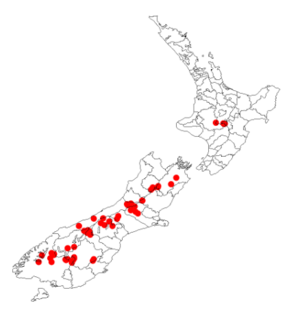Carex berggrenii facts for kids
Quick facts for kids Carex berggrenii |
|
|---|---|
 |
|
| AM AK330997 | |
| Conservation status | |
|
Invalid status (NZ TCS)
|
|
| Scientific classification | |
| Genus: |
Carex
|
| Species: |
berggrenii
|
 |
|
| Occurrence data from AVH | |
Carex berggrenii, also known as Berggren's Sedge, is a special type of grass-like plant called a sedge. It belongs to the Cyperaceae family, which includes many different sedges. This plant is only found in New Zealand, growing on both the North and South Islands.
Contents
What Does Berggren's Sedge Look Like?
Berggren's Sedge is a small plant that grows in clumps. It has a beautiful dark red-purple or orange-red color. Its stems, called culms, are smooth and round. They are about 15 to 30 millimeters (about 0.6 to 1.2 inches) long. These stems are mostly covered by light brown, leaf-like parts called sheaths.
The leaves of this sedge are long and narrow, almost flat. They measure about 30 to 60 millimeters (1.2 to 2.4 inches) long and 1 to 3 millimeters (0.04 to 0.12 inches) wide. They have clear lines, like veins, and their tips are not sharp but rather blunt.
This plant has special flower parts called spikes. The spike at the very top of the stem has only male flowers. It sits on a small stalk called a peduncle. Other spikes, which have female flowers, grow close to the base of the male spike. These female spikes are usually attached directly to the stem without their own stalk. The small leaf-like parts that grow below the flower cluster, called bracts, are longer than the flower cluster itself.
Berggren's Sedge flowers from October to February. Its seeds, or nuts, ripen and are ready to spread from October to June. These seeds are spread in two main ways: by animals eating them (called granivory) and by the wind carrying them away.
Where Does Berggren's Sedge Grow?
You can find Berggren's Sedge in the middle mountain ranges of New Zealand's North Island. In the South Island, it grows mostly in the eastern parts, starting from Lake Tennyson and going south.
This sedge prefers to live in wet areas, especially in mountains or near the tree line (montane to subalpine wetlands). It likes to grow along the edges of lakes and streams.
Is Berggren's Sedge in Danger?
Scientists in New Zealand keep track of how rare or common plants and animals are. This is done using the New Zealand Threat Classification System (NZTCS).
In 2013, Berggren's Sedge was listed as "At Risk – Naturally Uncommon." This means it's not found in many places, but this is natural for the species. However, in 2017, its status changed to "At Risk - Declining." This means that the number of these plants is now going down, which is a concern for its future.
Images for kids




